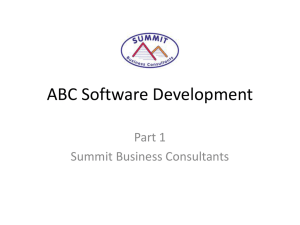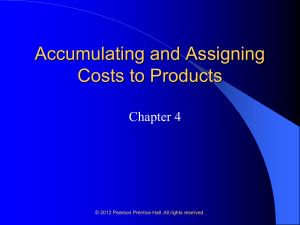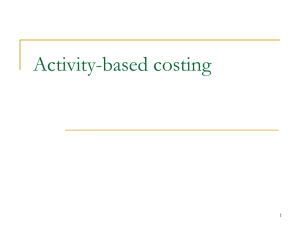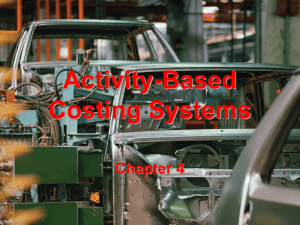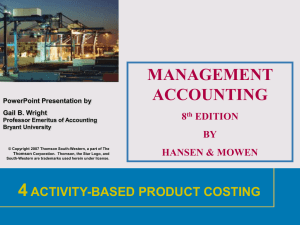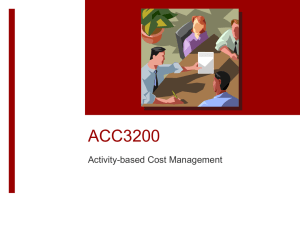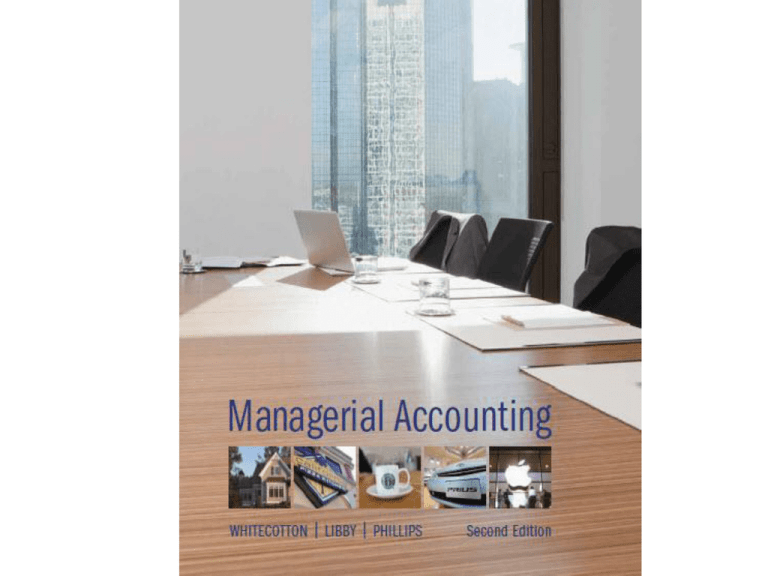
Chapter 4
Activity-Based Costing and Cost Management
PowerPoint Authors:
Susan Coomer Galbreath, Ph.D., CPA
Charles W. Caldwell, D.B.A., CMA
Jon A. Booker, Ph.D., CPA, CIA
Cynthia J. Rooney, Ph.D., CPA
McGraw-Hill/Irwin
Copyright © 2014 by The McGraw-Hill Companies, Inc. All rights reserved.
Assignment of Indirect Costs to Products
and Services
Two systems are used to track the total cost of
products and services
Process
Costing
Job Order
Costing
Indirect
Costs
4- 3
Learning Objective 4-1
Assign indirect costs to products
or services using a single
volume-based cost driver.
4- 4
Review of Volume-Based Cost
Systems
Recall from earlier chapters that there are three steps to
assigning indirect costs in a volume-based cost system:
1.Determine the cost driver (allocation base).
2.Calculate the predetermined overhead rate.
3.Assign indirect costs to individual products or services using
the predetermined overhead rate.
STEP 1: DETERMINE THE COST DRIVER
4- 5
Review of Volume-Based Cost
Systems
The next step is to compute the predetermined overhead rate
by dividing the estimated total manufacturing overhead cost by
the estimated total value of the cost driver, as follows:
STEP 2: CALCULATE THE PREDETERMINED OVERHEAD RATE
In our Toyota example, total manufacturing overhead cost of
$3,000,000 will be divided by the total number of direct labor
hours (12,500), as follows:
4- 6
Review of Volume-Based Cost
Systems
STEP 3: ASSIGN INDIRECT COSTS TO INDIVIDUAL
PRODUCTS OR SERVICES
To determine how much manufacturing overhead cost to assign
to the individual products, we multiply the $240 predetermined
overhead rate by the number of direct labor hours required for
each product, as shown below:
4- 7
Review of Volume-Based Cost
Systems
STEP 3: ASSIGN INDIRECT COSTS TO INDIVIDUAL
PRODUCTS OR SERVICES
To compute the unit manufacturing cost, we need to add the
manufacturing overhead cost per unit to the direct materials and
direct labor costs provided on a per-unit basis, shown below:
4- 8
Calculate Total Manufacturing Cost
and Profitability
If we subtract the total manufacturing cost per unit from the unit
sales price, we get the gross margin for each product. Remember
that gross margin only takes into account the manufacturing cost of
the product, before selling and administrative costs such as
distribution fees, advertising, dealer costs and profit, and corporate
administration charges have been deducted.
4- 9
Activity-Based Costing (ABC)
Two-Stage Allocation Process Using ABC
Activity Based
Costing (ABC) is a
method of assigning
indirect costs to
products and
services based on
the activities they
require.
4- 10
Learning Objective 4-2
Classify activities as unit-, batch-,
product-, or facility-level activities.
4- 11
Identify and Classify Activities
4- 12
Learning Objective 4-3
Assign indirect costs to activity cost
pools and select a cost driver for
each pool.
4- 13
Form Activity Pools and Assign Indirect
Costs to Each Pool
Assume that Toyota has grouped its
production activities into three
categories.
Machining
and
Installation
(unit level)
Machine
Setup
(batch level)
Engineering
and
Quality Control
(product level)
4- 14
Form Activity Pools and Assign Indirect
Costs to Each Pool
Recall that the total manufacturing overhead cost for the Tsutsumi plant is
estimated at $3,000,000 (in thousands) per year. 1n an ABC system, this indirect
cost must be assigned to the three activity cost pools.
4- 15
Form Activity Pools and Assign Indirect
Costs to Each Pool
Assume that the production engineer makes $120,000 per year and
has kept track of the time spent supervising the three major
activities. The number of hours spent on each activity is used to
allocate the $120,000 salary.
Since the supervisor spends 40% of his time overseeing
machining and installation activities, $48,000 (40% x $120,000)
should be assigned to that activity cost pool.
4- 16
Select a Cost Driver for Each Activity Cost
Pool
A cost driver is a measure of the underlying activity that occurs in
each activity cost pool. The goal is to identify a driver that has a
cause and effect relationship with the underlying activity. Traditional
cost systems use volume-based cost drivers. ABC systems also
include measures that capture something other than the sheer
volume of units produced or customers sold. These measures are
called non-volume-based cost drivers.
4- 17
Select a Cost Driver for Each Activity Cost
Pool
Machine hours will be used as
the driver for the machining
and installation activity.
Number of set-ups will be
used as the activity driver for
the set-up activity.
Engineering and inspection
hours will be used as the
driver to assign engineering
and quality control costs.
4- 18
Learning Objective 4-4
Assign indirect costs to products or
services using activity rates.
4- 19
Assign Indirect Costs to Products or Services
Based on Activity Demands
There are two methods that can be used to assign indirect costs
to individual products or services based on their activity
requirements: activity rates or activity proportions. The method
used will depend on the type of information provided and whether
you have complete information on all product or service lines.
Activity
Rates
Activity
Proportions
4- 20
Activity-Rate Method
The activity-rate method is very similar to the
predetermined overhead rate computed earlier.
Total indirect costs assigned to the machining pool was $720,000.
Total machine hours required by each Toyota model is as follows:
$720,000
Activity Rate =
= $72 per machine hour
10,000
4- 21
Activity-Rate Method
To assign the cost to the products, we multiply the
activity rate by the activity requirements of each
individual product.
4- 22
Learning Objective 4-5
Assign indirect costs to products or
services using activity proportions.
4- 23
Activity-Proportion Method
The activity-proportion method can also be used to assign
the total cost of the machining and installation pool of
$720,000. This method will calculate activity proportions
or percentages of the cost driver, machine hours.
4- 24
Activity-Proportion Method
The allocation of the machining and installation
cost of $720,000 to the specific models is shown
in the table below.
4- 25
Compute Total Manufacturing Overhead
To complete the ABC allocations, we need to add up the
cost of all three activities for each product line.
Notice that more of the total manufacturing overhead
cost is assigned to the Prius than the Scion.
4- 26
Calculate Unit Costs and Gross Margin
To calculate the cost per unit, we need to divide
the total manufacturing overhead by the
number of units of each product.
4- 27
Calculate Unit Costs and Gross Margin
To determine the total manufacturing cost per unit, the
manufacturing overhead calculated using ABC is added to
the direct materials and direct labor costs.
4- 28
Calculate Unit Costs and Gross Margin
In this hypothetical example, subtracting the unit
manufacturing costs under ABC from the unit sales
price provided earlier results in the following gross
margin analysis.
4- 29
Learning Objective 4-6
Compare the results of a volumebased cost system to activity-based
costing.
4- 30
Comparison of Volume-Based and ActivityBased Cost Systems
A comparison of the unit manufacturing overhead per unit and the
gross profit margin percentage of each product under a volumebased system to activity-based costing illustrates the different
results from the two cost systems. Remember that the only
difference between the two methods is in how they assign indirect
costs (overhead) to each product.
4- 31
Learning Objective 4-7
Apply activity-based costing to a
service industry.
4- 32
Activity-Based Costing in Service Industries
ABC can also be useful in service industries, particularly
when different types of customers require different levels of
service. Although service providers do not have
manufacturing overhead, they incur many indirect costs,
such as rent, supplies,
supervision, advertising, and administrative expenses.
4- 33
Activity-Based Costing in Service Industries
The activity-based costing process begins by identifying and
classifying activities using the activity hierarchy.
4- 34
Learning Objective 4-8
Describe how managers use the
results of activity-based costing for
cost management.
4- 35
Activity-Based Management
Activity-based management (ABM) includes all the
actions that managers take to improve operations or
reduce costs based on the ABC data. The first step in
any improvement program is to target areas that need
improvement.
What
Activities
Are
Performed?
How Much
Does it Cost
to Perform
Each
Activity?
Does the
Activity Add
Value to the
Customer?
4- 36
Just-in-Time (JIT) Inventory
In a JIT system, materials are purchased and units are
made only as they are needed to satisfy customer demand.
JIT is a "demand pull" system, where materials and
products are pulled through the manufacturing system
based on customer demand.
In a traditional manufacturing setting, products are
pushed through the system and often end up sitting in
inventory.
4- 37
Total Quality Management
Total quality management (TQM) is a management
approach that aims to improve product quality by
reducing and eliminating errors, streamlining activities,
and continuously improving production processes:
1.Prevention costs;
2.Appraisal or inspection costs;
3.Internal failure costs; and
4.External failure costs.
4- 38
Target Costing and Life Cycle Cost
Management
Target costing is a proactive approach to cost management
that managers can use to determine what costs should be
in order for the company to earn an acceptable profit
across a product’s life cycle. The product life cycle
represents the life of the product from its infancy (an idea),
through design, development, product introduction,
growth, maturity, and eventual decline.
4- 39
Target Costing and Life Cycle Cost
Management
In pursuing cost management, managers need to set their
cost reduction goals across all stages of the product life
cycle, including:
1. product introduction,
Costs tend to be higher
2. growth,
Most revenue earned
3. maturity, and
4. eventual decline.
In today’s digital and technological age,
product life cycles become increasingly short.
4- 40
Target Costing and Life Cycle Cost
Management
With target costing, the price is set by the market based
on what the company believes consumers will be willing
to pay for the product or service. The desired profit
margin is then subtracted from the market price to
determine the target cost.
The $24,000 target cost is the most that can be spent on the
product and still achieve the 20% return on sales (given a
market sales price of $30,000 per unit).
4- 41
Target Costing and Life Cycle Cost
Management
Given the target unit cost, how much can Toyota
spend on the new model across its entire life cycle
and still meet the target profit?
The next step is to determine whether it is
feasible to design, develop, manufacture, and
deliver the product at a total life-cycle cost of
$1,440,000,000.
4- 42
Summary of ABC and ABM
To gain the true benefits of activity based costing,
managers must move from simply measuring costs, to find
ways to manage or reduce costs. Although ABC and ABM
have many potential benefits, these benefits must be
weighed against the costs of obtaining the more accurate
information. Implementing an ABC can be a difficult task.
4- 43
End of Chapter 4
4- 44


